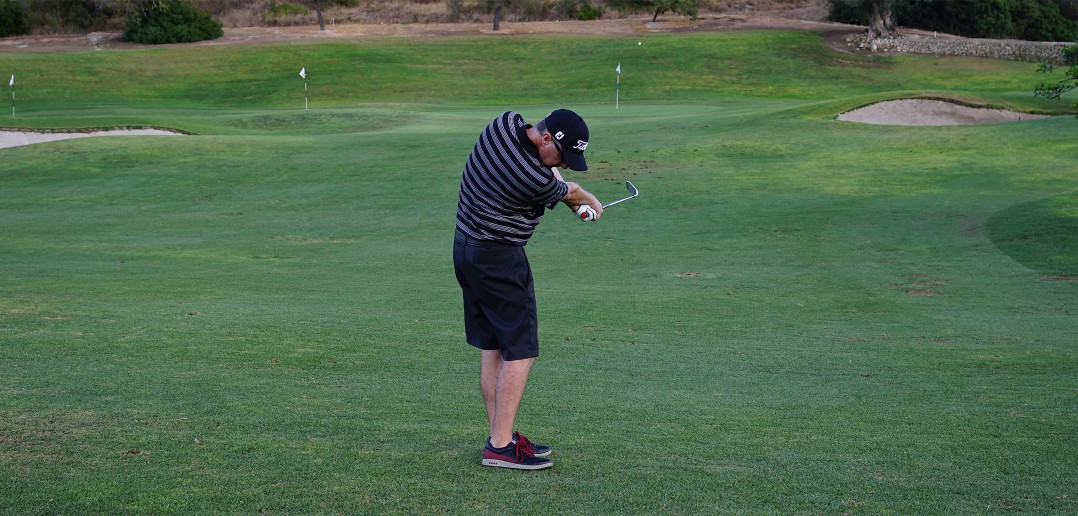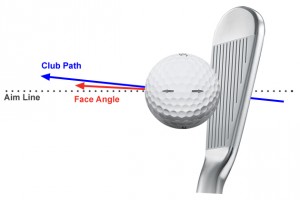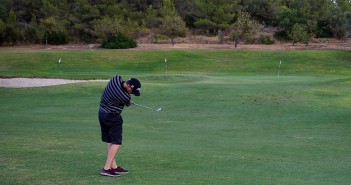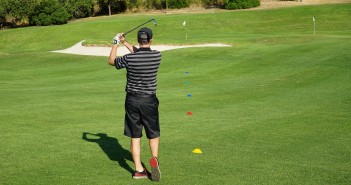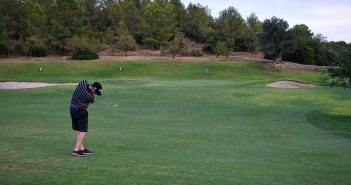With this drill you’re going to learn how to play the controlled draw – the most desired shot in golf, the envy of almost every amateur player. What’s more, you’re going to use exactly the same shot making techniques that are used by the best golfers in the world!
Other tuition gives you the basic information that you need in order to hit “any old draw”. That’s fine if you’re fighting a slice, or if you’re happy to just work the ball around an obstacle with a vague hope of getting it back into play, but it’s no good if you want to learn how to truly master your ball striking, to finesse your shots, plotting your way strategically around the course and attacking flags. To do this, to use the draw to go on the offensive and significantly lower your scores, you must learn how to play the controlled draw.
We’re not just teaching you how to compensate for swing flaws, to play a draw because it goes further, or to play these shots because they “look neat”. The aim of this article is to take your ball striking and shot making to the next level, and to give you a highly effective scoring weapon to use against the golf course.
In this three-part drill, we’re going to give you the knowledge and technique required to play these shots, together with a learning plan that will help you to quickly develop the fine control needed to attack a golf course.
You are quickly going to learn, and master, exactly the same techniques used by the world’s greatest golfers.
This is the first part of your road map to becoming a master shot maker.
This first drill in the “Working the Golf Ball” series forms part of the Golf Loopy Score like a Champion system for developing your wedge play, but this is also the best way to learn how to play these shots with any golf club. By starting with these shorter finesse swings, you will learn how to develop fine control over your swing path, club face angle and loft through impact in order to make the shots that you wish, on demand – something that you just can’t learn effectively at full speed. Whether you want to hit a booming high draw off the tee, or to finesse a shot against a crosswind to attack a tricky flag, this is the place to start.
But this drill isn’t just for the highly skilled golfer, either. By learning how to exercise fine control over your ball striking, you will be able to hit the ball straighter, further, and more consistently, too. And, on days where your swing isn’t quite as good as it should be, you’ll be able to feel what is going wrong, to self-diagnose the problem, and to either fix your swing mid-round, or to work with your swing-of-the-day, manage your way around the golf course, and fix the problem later.
What is a Draw, and What Causes It?
Let’s start by describing what a draw actually is, and how it works. You don’t need to be an engineer to play a draw, but a basic understanding of the principles involved will help you to control these shots.
For the remainder of this article, we’ll describe the shot from the point of view of a right-handed golfer. Apologies to our lefty friends, but it’s simpler for everyone this way.
A draw is a shot that curves from right-to-left in the air, or that works against a left-to-right crosswind.
This can range from the huge sweeping hook, to the elegant little one-yard draw that holds the ball straight against a crosswind. In this article, we’re talking about how to play shots through the whole range, but they must be played with control.
A draw is caused by the ball having a spin axis that is tilted to the left. Spin creates lift, and a left-tilted spin axis will “lift” the ball to the left during its flight.
The spin axis is tilted when the club path (the direction that the club head is moving) is different to the direction that the club face is pointing through impact. For a draw, the club face must be pointing to the left of (be “closed” to) the club path through impact.
The starting direction of the ball flight is determined, primarily, by the club face. The direction of curvature through the air (the spin axis tilt) is determined, primarily, by the club path relative to the club face. The face starts it, the path curves it. This relationship varies with the loft of the club. With a driver, the starting line of the ball is about 85% dependent on the club face angle, 15% on the path. With a mid-iron, the face has about 75% of the say in the direction that the ball starts. With a lob wedge the face has much less dominance – that’s why a flop shot, where the club face is way open and you have something approaching 80 degrees of loft through impact, doesn’t fly straight right.
There are other factors at play, such as the quality of the strike and gear effect, but those are discussed in detail elsewhere on this site. It’s important to be aware of these things, especially when diagnosing a missed shot, because your technique may be almost perfect but a mishit can turn a nice little draw into a nasty hook! Your first question after a missed shot should always be “Did I hit the ball cleanly with the middle of the club face?”
The simplest way to think of a basic draw is that, through impact, the club face is half as much to the right as the club path. For example, a swing that is 6 degrees from the inside through impact, with a face angle that is 3 degrees open to (pointing to the right of) the target, will produce a perfect little draw that lands by the pin – see Figure 1.
That may seem counterintuitive, an open club face for a draw?! But the club face is closed to the path, and the laws of physics mean that this will create a draw – starting the ball right and curving it left through the air.
Contrary to popular belief, for a controlled draw, the club face will rarely be closed to your aim, and never closed to the target! A club face that is closed to the target will create a nasty pull-hook that is the opposite of controlled.
Note also that the angles involved here are tiny. Six degrees is only one second on a clock face, yet it is enough to curve the ball 8 yards through the air for a 75 yard wedge shot (30 yards with the driver!) This is why we first need to learn to control the club with a finesse swing, rather than trying to feel such fine adjustments at 100mph!
An In-to-Out Swing Path?
Almost all golf instruction, when referring to the “draw swing”, describes and “in-to-out” swing path. That may, technically, have some truth, but, for many amateur golfers, it is grossly misleading!
It is crucial to understand, if you are ever to be good at this game, that all good golf swings have a path that is in-to-square-to-in.
In a draw swing, you will strike the ball when the club path is still on the “in-to” part of an “in-to-square-to-in” path, so this is, technically, moving in-to-out at impact. But “in-to-out” implies, in the minds of most students, a follow-through that is “out”, and that’s very wrong! Trying to “swing out to right field” will destroy your golf swing!
You absolutely must swing “in” and “up” in the follow through, never try to swing out to the right, and, contrary to popular belief and a huge body of misleading instruction, never try to swing “down the line”! If a golfer with a good swing tried to swing “down the line” or “out to the right”, he would hit a very nasty snap hook! That’s why you see the best players in the world making practice swings that exaggerate an “in and up” follow-through.
An amateur golfer who tries to swing down the line or out to the right will instinctively stall their body rotation and swing their arms out away from their body, losing both power and consistency. For a great golf swing, you must continue to rotate your body through, “covering the ball” through impact, so that your hands are still in front of your sternum, and your upper arms are close to your body, well into the follow-through.
For the rest of this article, we’ll stay away from describing a draw swing as having an “in-to-out” path, and instead use the more instructive term “inside attack”. A path that “attacks the ball from the inside” will produce a controlled draw, when matched to the correct club face orientation.
The Drill
…
or Log In
…Ultimately, a great golfer, a master of his craft, won’t need to worry too much about technique. This golfer will look at the shot, visualise the ball moving through the air, react to the target and just think “draw”. It doesn’t much matter where their feet are pointing, it’s just a matter of feel. But you need to earn this level of control through intelligent practice.Work on this drill and, in no time at all, your ball striking will improve markedly, your confidence will soar, and you’ll have a fantastic tool to help you to dismantle a golf course.
Next up: Learn to hit the Tour pros’ favourite shot, in Wedge Play Drill 109b – Technique: How to Play a Controlled Fade.

